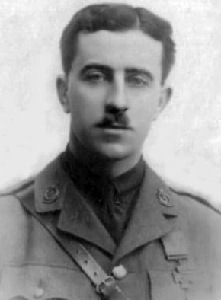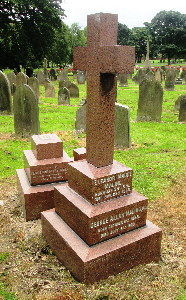
Captain George Allan Maling V.C.
Obituary: British Medical Journal 27/07/1929
Gallaghers WW1 Card VC Recipients
Maling Pottery History: Photo H. Maling

Bishopwearmouth Cemetery - Parents' grave 2017
George was born in Bishopwearmouth, Sunderland on the 6th October, 1888 at Carlton House (now part of the Church High School), Ashbrooke, Sunderland. The youngest of nine children. [His mother's family originated from Scotland and had established a glass making business in Sunderland in the 1830s]. He was a maternal cousin of Sir Henry Havelock.
The family were part of the Maling Pottery family.
George was educated at Uppingham School, and graduated with honours in natural sciences from Exeter College, Oxford. He continued his studies at St Thomas' Hospital, where he obtained the Degrees, M.A.; M.B.; B.Ch. Oxon; M.R.C.S. in 1914 and L.R.C.P. in 1915. He then obtained a temporary commission in the R.A.M.C. on the 18th January 1915. After five months he joined the 12th Battalion, The Rifle Brigade (Prince Consort's Own) as their medical officer.
George arrived in France on the 20th July 1915.
"The Battle of Loos formed a part of the wider Artois-Loos Offensive conducted by the French and British in autumn 1915, sometimes referred to as the Second Battle of Artois, and comprised the major Allied offensive on the Western Front in 1915. The Loos offensive began on 25th September following a four day artillery bombardment in which 250,000 shells were fired, and was called off in failure on 28th September. Presided over by General Douglas Haig, the British had committed six divisions to the attack despite serious misgivings regarding the unavailability of a further two divisions as reserves. This delay in making available the reserves was crucial. The Germans poured in reserves to counter-attack the following day when the British no longer had the benefit of a preliminary artillery bombardment.
Advancing towards the astonished Germans that afternoon without covering fire, the "Tommies" were cut down by repeated machine gun fire. After several days of sporadic fighting, the British were eventually forced to order a retreat. During the battle the British forces suffered 50,000 casualties. German casualties were estimated much lower, at approximately half the British total.
It was against this backdrop of carnage that Lieutenant George Maling of the Royal Army Medical Corps attached to 12th Battalion of the Rifle Brigade (now the Royal Green Jackets) won his Victoria Cross.
At dawn on the second day of battle a group of British soldiers were trapped in the area of a ruined house in "no man's land", near Fauquissart, by a murderous artillery barrage, with the screams of the wounded carrying to the British lines, where their comrades were unable to give them support because of the intensity of the shelling. Despite this, and on being advised that were some three-hundred wounded around this ruin, Maling shouldered his medical pack, shouted for his orderly and jumped the parapet and ran through curtain of exploding steel, and inexplicably arrived at ruin unharmed. He then set about his duties conscientiously and systematically, despite the incessant barrage, and the consequent escalation in casualty numbers.
Accompanied by his orderly, Maling moved from casualty to casualty, never hurrying, dressing wounds, carrying less seriously wounded men to more comfortable positions, and giving solace and as much palliative care as circumstances would permit to the more serious injured.
Both men worked through the day, taking cover only when the bombardment became too intense, and even then Maling sought to protect his patients with his body. Eventually, and inevitably, a shell exploded almost over-head of the two men, throwing them a distance.
Lieutenant Maling found to his surprise that he was uninjured, his orderly however, was not so fortunate and lay wounded amongst a pile of bodies. Dazed, Maling struggled to his feet, pulled his orderly clear, and commenced to treat his wounds. At this point, Maling heard the faint cry of a comrade begging for water, and as he made his way to this unfortunate soldier another artillery shell exploded near-by flinging Maling to the ground, covering him with debris and blowing his bag out of his hand.Most incredibly he again escaped unhurt, and so crawled about on his hands and knees recovering his lost medical equipment, and re-commenced treating the ever growing band of injured and dying as the barrage continued pitilessly throughout that terrible and Hellish day.
As night fell the bombardment lessened in intensity, becoming more sporadic. Maling was therefore able to commence transporting the wounded to relatively safer places. Not once during this long night of wounded and dying soldiers did Maling think of leaving his patients and returning to the safety of British lines, instead he continued alone in his selfless and gallant humanitarian work, with great commitment and courage.
As dawn broke, the early light showed hundreds of dead around the area of the ruined house, but almost three hundred alive but wounded. Again a haggard and tired Maling continued moving from man to man giving what treatment he could and trying to raise their spirits.
By 8am the German gunners ceased their attack, and British rescue teams were able to move forward to bring the wounded back to casualty stations and thence away from the "Front". For the most conspicuous bravery and devotion to duty in collecting and treating more than 300 wounded, all the time under heavy shell fire and in the open Lieutenant Malling was awarded the highest honour that can be bestowed on a British soldier — the Victoria Cross.
London Gazette 18th November, 1915.
During the heavy fighting near Fauquissart on the 25th September 1915, Lieutenant Maling worked continually with unceasing energy from 6:30am on the 25th September until 8am the following day. He collected and treated more than 300 wounded, all the time under heavy shell fire and in the open. At around 11am on the 25th September he was thrown down and stunned by the detonation of a large high explosive shell. This explosion wounded his assistant and killed several of the patients. Soon after the explosion of a second shell covered him and his instruments with debris. He continued alone with great zeal and courage.
George Maling was also *mentioned in despatches and promoted to Captain in 1916. He subsequently served a short time at the Military Hospital, Grantham, and then returned to France for two years with the 34th Field Ambulance of the 11th Division.
The Sunderland Echo and Gazette dated March 17th 1917, had this report Capt Maling V.C.:
The engagement, which is of interest to Sunderland, is announced of Captain George Allan Maling, V.C., R.A.M.C, to Miss Daisy Mabel Wolmer, A.R.R.C., and the marriage will take place quietly early in May.
Capt. Maling is a native of Sunderland, and the youngest son of Dr Edwin Allan Maling and Mrs Maling, of Blackwell Hall, Darlington, and formerly of Sunderland. He was educated at Uppingham and Exeter College, Oxford, where, after a brilliant scholastic and athletic career, he took the M.A., M.B., and B.Ch. degrees, and the M.R.C.S., L.R.C.P. diploma. He received a commission in the R.A.M.C. In January 1915, and twelve months later was awarded the V.C. for distinguished bravery and devotion to duty in the field at Loos in September, 1915.
He had been stationed at the Military Hospital, Grantham, for the past ten months.
Miss Wolmer, who is a daughter of Mr George S. Wolmer and of the late Mrs Wolmer, of Winnipeg, Canada, is also connected with the hospital at Grantham. She is a member of Q.A.I.M.N.S., and last month at Buckingham Palace had the R.R.C. conferred upon her by the King.
Daily Mirror Monday 7th May 1917 carried a report of his wedding:
V.C Hero Weds Nurse.
Army Nurses Cheer Bridal Couple as they Leave Church".
An interesting wedding took place on Saturday at St. Nicholas' Church, Sutton, between Captain G.A. Maling, V.C., of the R.A.M.C., of Darlington, and Daisy Mabel Wolmer, R.R.C., daughter of Mr. and Mrs. George Stephen Wolmer , of Winnipeg Canada.
The bride was given away by Captain E. Mortimer, of the Navy, and the ceremony was attended by some Army Nurses, who cheered the couple as they left the church.
The bridegroom received his commission in the R.A.M.C. in 1915, and gained the V.C. for bravery at Loos in September, 1915. He was stationed at a military hospital at Grantham, and Miss Wolmer, the bride, was a nurse at the same institution since May, 1915.
They had 4 children. John Allan MC (1920–2013), served in the Second World War and also became a doctor. He married Daphne Judith ("Judy") Haines in 1952 and had issue. Phyllis Mary (1922–2008), married Richard David Mortlock (1923–1976) and had issue. Edwin Lambton (1922–1941), died suddenly, aged 19, at the Royal Hospital School after recently enrolling in the Royal Navy. Barbara (1926–1949).
After being demobilized at the end of the war George Maling obtained the post of residential medical officer to the Victoria Hospital for Children, Chelsea. He then subsequently commenced general practice in Lee, and was appointed surgeon to out patients at St, Johns Hospital, Lewisham. He was residing at 'St Monicas' Micheldever Road, Lea SE12.
George Allan Maling V.C. died on 9th July 1929 at the age of 40, after suffering from pleurisy.
Maling's obituary incorrectly states he left one son.
His medals are held by the Museum of Army Medical Services, Aldershot.
George Maling's headstone is in Chiselhurst Cemetery, Kent.
Source: British Medical Journal
George Maling is remembered at Bishopwearmouth Cemetery on his parent's headstone.
* Mentioned in Despatches (MID) is a military award for gallantry or otherwise commendable service. A despatch is an official report from a senior commander, usually of an army, to his superiors, detailing the conduct of military operations. In the British Armed Forces, this report is published in the London Gazette. If a subordinate officer or soldier performs a noteworthy action included in the report, he/she is said to have been "mentioned in despatches".
However, no trace of his MID has been traced.
A brief history of Maling Pottery: Maling pottery was founded in 1762 in North Hylton near Sunderland, UK by the Maling family. Originally the company produced utilitarian pieces of unremarkable quality but by the 1890s the company had begun aiming at the higher end of the market and their wares appeared in stores such as Harrods of London.
The company was very successful and made over 16,500 patterns over its 200 year history. WWII was a huge blow to the company and it gradually declined and succumbed to the competition. The Maling factory closed in 1963.
Additional research: James Pasby.
On the 25th September 2015, a commemorative VC stone was placed in Sunderland, to mark 100 years since Captain Maling was awarded the Victoria Cross.
George Maling is remembered in Sunderland on S140.160 and S140.161
Army Medical Services Museum
Kent Fallen
The Maling Collectors Society Photo of pottery site
History of Maling Pottery

